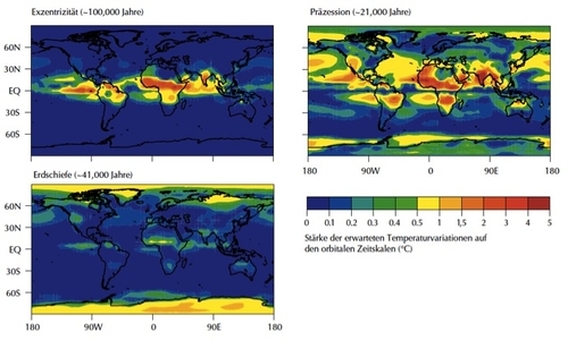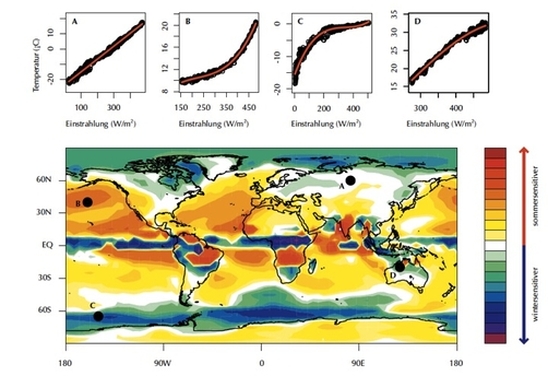What does the annual cycle tell us about climate change
in the last millions of years?
Regular temperature variations are shaping the Earth’s climate on long time scales. Ice ages and interglacial ages are the most known variants. Very slow climate change is attributed to variations in the Earth’s orbit around the Sun: the eccentricity of the Earth’s orbit (~100,000 years), the Earth’s axial tilt (~41,000 years) and the precession, the gyration of the rotation axis (~21,000 years). Current research investigates several questions: Which is the mechanism that transfers small variations in the radiation budget into an impact on climate? Are these cycles shaped globally? How do they vary from place to place; do the poles, for example, vary in a synchronous or in an opposite way? To approach these questions, it is useful to analyse the insolation and temperature of the modern seasonal cycle, i.e. the last ten to 50 years. The Earth-Sun geometry influences the climate during the seasonal cycle as well. As the insolation can be computed and the modern temperature is directly measured, this cycle can be analysed in detail. It becomes apparent that the temperature does not simply follow the solar insolation. Depending on the region, the Earth reacts more or less sensitive to summer or winter insolation. (Fig.1)
Regional relation between surface temperature and solar insolation and map of seasonal temperature sensitivity. A: On extratropical land areas, the temperature reacts homogeneously to insolation during all seasons. B: The reduced depth of the ocean mixed layer in summer increases the sensitivity to summer insolation. C: Sea ice in winter reinforces the reaction to insolation in winter. D: Rainfall in summer weakens the impact of summer insolation on the temperature. (Modified by: T. Laepple und G. Lohmann, PO 2009.)
This is caused by different factors: seasonal changes in sea ice cover, variations in the ocean mixed layer depth as well as seasonal rainfalls. These seasonally dependent reactions also have a long-term influence on climate change. The reason: The variation in the Earth’s orbit keeps the mean annual insolation nearly constant, but it redistributes energy between the seasons, i.e. less insolation in winter and more in summer or vice versa. When the climate reacts sensitive to an insolation change of a specific season, the insolation signal translates into a long-term temperature signal and thus influences the annual mean. The measured climate response is now applied to the insolation time-series of the last millions of years. The results: A large part of long-term climate variability, which was derived using complex climate models, can be explained by local reactions to insolation changes. Furthermore, the predicted temperature variations strongly depend on the region (Fig. 2). The temperature in one area can thus be shaped by the precession cycle while an adjacent area varies in time with the Earth’s obliquity (tilt). Climate indicators confirm this observation. When interpreting climate indicators, we also learn from the modern annual cycle. Owing to the seasonal change of snow accumulation in Antarctic ice cores, the temperature signal in the ice core, cannot be interpreted as an annual mean: As snow evaporates in summer, part of the summer signal gets lost. The temperature signal in the ice core is thus biased. Contrary to the classical approach that the summer signal of the northern hemisphere is found in the Antarctic temperature reconstruction, the detected pattern of the precession of the Earth’s axis can also be interpreted more simply as a response to local insolation in combination with seasonal snow accumulation.
Temperature variations of the last millions of years. The maps show the strength of the temperature variations that are expected due to local insolation in the respective rhythms of the Earth-Sun geometry. (Modified by: T. Laepple und G. Lohmann, PO 2009.)

